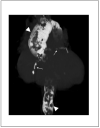Aortitis
- PMID: 18541754
- PMCID: PMC2759760
- DOI: 10.1161/CIRCULATIONAHA.107.760686
Aortitis
Figures








References
-
- Foote EA, Postier RG, Greenfield RA, Bronze MS. Infectious Aortitis. Curr Treat Options Cardiovasc Med. 2005;7:89–97. - PubMed
-
- Virmani R, Burke A. Nonatherosclerotic Diseases of the Aorta and Miscellaneous Disease of the Main Pulmonary Arteries and Large Veins. In: Silver M, Gotlieb A, Schoen F, editors. Cardiovascular Pathology. 3rd ed. Churchill Livingstone; Philadelphia: 2001. pp. 107–137.
-
- Gravanis MB. Giant cell arteritis and Takayasu aortitis: morphologic, pathogenetic and etiologic factors. Int J Cardiol. 2000;75(Suppl 1):S21–33. discussion S35-26. - PubMed
-
- Tavora F, Burke A. Review of isolated ascending aortitis: differential diagnosis, including syphilitic, Takayasu's and giant cell aortitis. Pathology. 2006;38:302–308. - PubMed
-
- Miller DV, Isotalo PA, Weyand CM, Edwards WD, Aubry MC, Tazelaar HD. Surgical pathology of noninfectious ascending aortitis: a study of 45 cases with emphasis on an isolated variant. Am J Surg Pathol. 2006;30:1150–1158. - PubMed
Publication types
MeSH terms
Grants and funding
LinkOut - more resources
Full Text Sources

